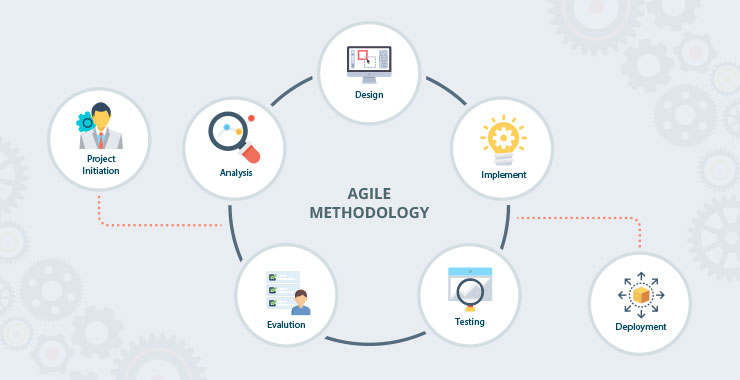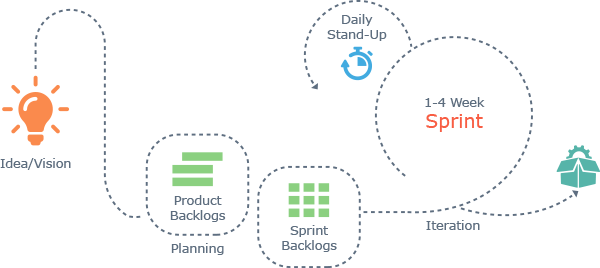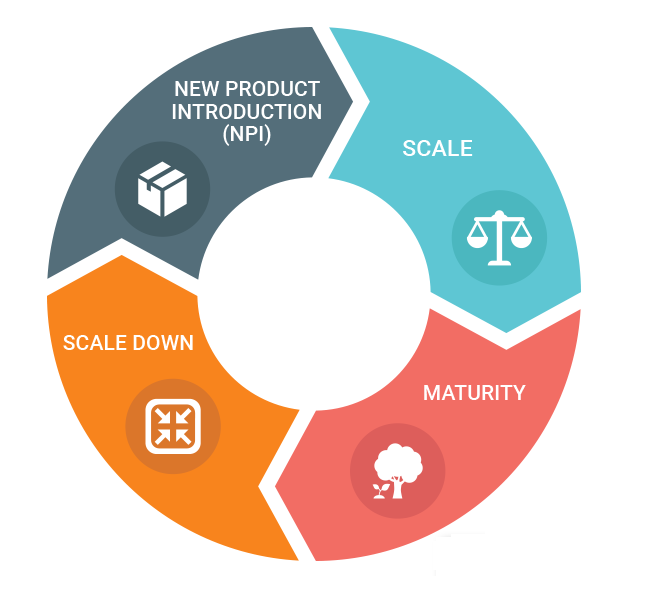Blog Tag: software development methodologies
Rushing Product Development? – Things To Know About Software Development Methodologies

As challenging as creating and prioritizing a product development, selecting the software development methodology, you will use to handle it may be more challenging. Even though every software development methodology ensures that the software meets all its requirements, each software has its own set of unique pros and cons. It will help you think twice before rushing a product development process. So here is a definitive guide to the latest and most popular software development methodologies we operate with to help you choose better. Let’s dive in!
Agile software development methodology

Agile is the creation of 17 tech mavens and their Agile Manifesto. It is a widely popular software development methodology that emphasizes adaptive planning, evolutionary development, and continued enhancement over flexible response modifications. The final goal is prompt software release with a lesser risk of bugs or errors.
Pros:
- It’s an adaptive methodology that reacts to the alterations in requirements speedily and efficiently.
- Receiving continuous feedback diminishes significant risks later on.
- Constant communication develops transparency between the team and the client.
- It concentrates on working with software, which means there is minimal documentation to be concerned about.
Cons:
- Increased or altering scope and the absence of focus can be an issue if the brief is vague.
- A lack of documentation can grow the risk of miscommunication.
Scrum development methodology

This development methodology is best suited for quick-changing projects with close neck deadlines. It is intended for teams comprising three to nine members, who divide their work into chunks to finish within a set time, generally two weeks. Daily, the team evaluates its progress in stand-up review meetings called Daily Scrums.
Pros:
- It hustles up the entire development process and is capable of bringing slow-paced projects back on track.
- Decision-making is majorly in the development team’s hands, who put effort at their own pace towards completion. It enables them to be attentive and increases motivation.
- It’s flexible, which permits regular changes and updates.
- A daily scrum meeting helps the managers to measure the extent of individual productivity. It also enhances productivity and collaboration among the team members.
Cons:
- It is apt for small, fast-paced projects but maybe not appropriate for more significant projects.
- This methodology requires an experienced team who are working close by to each other. Having trainees and time zone variations could push back the project delivery dateline.
- Team members must possess comprehensive skills that enable them to work on tasks apart from their specialization area. Sometimes a couple of team members might need extra training.
- Splitting the product development into short sprints needs comprehensive and careful planning.
Dynamic systems development model methodology
This methodology has its origins in the RAD model. It’s an iterative approach that focuses on continuous improvement and abundant user participation. Instead of focusing only on software development and coding, it tags along with project management and project delivery. It is the main reason for its frequent usage for non-technical projects. Its foremost aim is to offer the product or service on time and inside the budget range.
Pros:
- Users are very much involved in the development process just to get an impression of the software ahead of schedule.
- Better-quality, transparency, and incremental development help to minimize risk factors.
Cons:
- DSDM is quite expensive to implement as it needs ten plus dedicated roles, in addition to regular testing
- It isn’t apt for smaller organizations owing to more number of roles wanted.
How to choose the right methodology?
While deciding on a methodology isn’t tranquil, a little study and planning can go a long way. Bring together your list of strengths and weaknesses of your team. Look into which methodologies can complement your team’s capabilities and working style. Finally, filter down your options further by associating which models would serve your projects and clients best.
You may even try out a few of these methodologies on an experimental basis, which is easier for some than others. Over time, you’ll find out which methodology or combination of the works aptly for your team.
Final Thoughts
Often, companies rush into product lifecycle development and wish to crack a challenge right away. It is more like yesterday is better. While Product Lifecycle Management can enable the impact of enterprise-wide development, a hurried description of what should be solved and a correspondingly hasty decision on the solution to help those processes will not work for you in the long run.
Give some thought about the product data interconnectivity. Experience your data in a point of reference or try it on a live system. Then, after you make a choice, continually put the solution to the test. Quickly implement the main objective, place it in the users’ hands to test, and make incremental improvements to get the most of the ROI. Use innovative ideas as much as you can to counterpart your competitive edge.
Despite everything, the solution must serve you, and not the opposite way around. Wish to know more about product lifecycle management software, reach out to our experts. For inquiries regarding the project, development drop us an email at contact@topsinfosolutions.com.
Emerging Future Trends in Product Lifecycle Management Software

Product lifecycle management (PLM) software, a holistic approach to product development, has evolved dramatically over the years. From idea conception to repurposing, reuse, and recycling, it integrates the fundamental aspects of a product’s lifecycle. It brings people, processes, and data together for a flawless collaborative network. During PLM software implementation in your organization, each team must be prepared to face a new approach towards product development.
What is Product Lifecycle?
Many phases are present in a product lifecycle. They are as follows.
-
- Innovation & Design: The primary phase of a product lifecycle is the fundamental concept or idea. Here, exploring new product ideas, selecting the best one for development takes place. Innovators come up with improved product designs and solutions. Full-fledged product designs are in place; necessary materials are chosen, virtual and real prototypes are built for testing until operating conditions are met.
-
- Data Management & Simulation: Data Management lets organizations effortlessly access detailed product design information. The product data is kept safe and accessible by authorized personnel. Testing includes validation, simulation, and optimization tools that can react to real-time data and offer valuable product analysis insights.
-
- Manufacturing & Marketing: The product manufacturing phase is where the production begins. PLM tools like Production Planning help organizations to build more agile and productive production processes. It is the phase that helps to attain a faster time-to-market and manufacture the product successfully for marketing. Marketing strategy formalization based on the key target audience, different communication modes are applied next. PLM solutions offer all-inclusive tools to support marketing teams in pushing products to the market.
-
- Maintenance & Repurposing: This phase includes collect feedback on the product and its performance, maintaining and optimizing future product versions. Maintenance and operations tools offer essential support to your customers.
Benefits of product lifecycle management software
- PLM software helps organizations to maintain value in the product lifecycle by offering suitable tools to close the manufacturing cycle.
- It can also help you recycle, reuse, and repurpose your product’s elements during its lifecycle completion.
- It helps to cut back resource outlay in upcoming product development.
- It optimizes both manual and automated operations and makes sure it is in harmony
- It advances the work output of the employees
- Enables collaborative work environments and provides a higher level of security
- It helps to offer more customized solutions to meet the customers’ requirements
- It makes it easier to build in higher levels of closed-loop quality
Here we have concised a few significant trends that we can look out for with PLM software.
-
- Partnering with Augmented Reality – with augmented reality, development teams can visualize the product from any perspective. It also enables the users to review the product’s virtual prototypes in all possibilities
-
- Bringing together humans and machinery – The ability to connect people with wearables or smartphones can be done by product lifecycle management software configuration. It enhances workforce productivity and overall quality. For instance, in a manufacturing plant, it can measure the new product introductions with digital simulations, thus making ways for probable scenario analysis.
-
- Secure environment – In worldwide manufacturing industries, it is essential to handle massive volumes of confidential data where Intellectual Property is involved. PLM vendors, suppliers, and manufacturers all need trustable product or software development methodologies by having total data access control. PLM software offers a secure collaborative environment for both outsides and within the organization.
-
- Customization made easy – Having a solid foundation of traceability and version control expands the possibility of several variants. It also increases the opportunity to build customer and supplier relations as they are interlinked. It enhances the customization or mass personalization, which can be done by having Product Lifecycle Management tools. Not only can it help with attracting new customers or customer retention, but it can also have a distinct competitive edge.
- Total integration –Software can have a differentiating impact on product lifecycle. As the software complexity in manufacturing upsurges, products need more significant integration levels in the product development process and the entire lifecycle. Keeping both mechanical and electronic software teams in sync and maintaining effective integration among electronic, mechanical, and software product data elements will always be in great demand.
The future
The consumer demand for a combination of product development and global operations may give rise to a brand new interactive experience. From gathering product requirements to predictive maintenance of products and services, Product Lifecycle management software can be the deal. In addition to that, the joint information on virtual and physical products may result in a new demand for data analysis and management.
Final thoughts
Product Lifecycle Management is all about how a product needs to be developed and the various phases it undergoes before it is fully operational for its customers. Having PLM software can provide you with the necessary insights for your employees owing to their tasks and responsibilities.
We help provide the best-customized software development and management solutions that meet your requirements on point. To Reach us, call on +1 408-400-3737 or drop and email at contact@topsinfosolutions.com